High grade uranium boulders yield anomalous gold values from ESO/Fission JV at Patterson Lake uranium property

VANCOUVER, Sept. 28, 2011 /CNW/ – ESO Uranium Corp. (TSXV: ESO), (the “Company” or “ESO”) and its 50% Joint Venture (JV) partner Fission Energy (TSX-V: FIS), announce further results from its June 2011 uranium boulder prospecting and radon soil gas survey program:
- Of the 74 samples of boulders and mineralized soil samples submitted for fire assay, 9 samples returned anomalous gold values ranging from 0.101 g/t gold to 2.43 g/t gold.
- The grades of the gold samples have a loose correlation with the uranium grades in the boulders.
- This reflects a general association of gold and uranium which is also reported in the largest South West Athabasca Basin deposits. The Shea Creek Deposits of Areva-UEX (with approximately 90 million pounds) and the former producing mines of Amok (Areva) at Cluff Lake (approximately 60 million pounds produced) are examples. This suggests that elevated gold values may be characteristic for deposits in the South West area.
- The focus of much of the exploration activity in the Athabasca Basin has been attracted by the large high grade deposits in the East Athabasca Basin. But the reality is that the South West Athabasca Basin has rewarded exploration with two areas of significantly large and high grade deposits, one of which became a stand-alone mining operation in a remote location.
Drill targets have been selected from a broad review of technical data including geophysical surveys and parameters suggested by data from diamond drill hole information in assessment reports presented by Canadian Occidental in the late ’70s. The geophysical data indicate several strong ground EM conductors on the southwest end of the Patterson Conductor Corridor which appear to have been disrupted by large cross cutting structures. These are associated with a low magnetic area that could be interpreted as an alteration feature.
Permitting is well advanced for a 15 hole drill programme to test these targets, supported by geophysical surveys to confirm geological structures and conductors and trenching to confirm local ice directions. Local ground conditions should allow work to continue through freeze up.
The source of the uranium boulders is expected to be a basement hosted system located in an area where the Athabasca and Cretaceous sedimentary rocks have both been excavated away by ice action. This constraint of a restricted erosional window reduces size of the search area, which also is expected to lie within the path along which the ice sheet pushed out the boulders found in the moraine.
The substantial size of many of the well mineralized boulders, which could be quickly crushed to sand and gravel sized material by the action of the ice transportation, suggests that the travel distance from source also may be constrained. Assessment reports from Amok Ltee (Areva) describe the exploration work which lead to the discovery of the Cluff Lake Mines by drilling up-ice, generally NE, from uranium boulder clusters, to locate sources in several discrete deposits. A fairly regular separation of 2 to 3 kms is indicated between boulder clusters and the bedrock sources (mines) that were located.
The SW end of the Patterson Conductor Corridor lies roughly NE, about 3 kms from the centre of the boulder field where some of the larger boulders were located. The drill hole data available include geological logs and down-hole radiometric surveys which in one hole, 250 meters from the target area, showed two short intervals of sharply anomalous radioactivity in the basement rocks intersected. This suggests possible proximity to mineralization.
The Patterson Conductive Corridor runs along the boundary zone between the Clearwater and Western Granulite Domains, which according assessment reports submitted by the predecessor company of Cameco (TSX:CCO), is interpreted to have had a favourable geological history analogous to the highly productive Wollaston Domain along its boundary with the Mudjatik Domain in the East Athabasca Basin.
The JV Partners, ESO Uranium and Fission Energy, carried out state of the art magnetic and airborne radiometric surveys in 2009 which, with detailed ground follow up in 2011, led to the discovery of a boulder field with an unusually high percentage of high grade uranium boulders. The boulder field was spread over a north-south distance of approximately 5 kms and has a maximum east-west width at present of more than 900 meters.
The samples were analysed by SRC Geoanalytical Laboratories (an SCC ISO/IEC 17025: 2005 Accredited Facility) of Saskatoon for analysis, which included a 63 element ICP-OES, uranium by fluorimetry (partial digestion). The partial analysis is carried out to determine if the uranium is available for extraction by normal metallurgical processes. The multi element analysis was supplemented by fire assay determination of the gold values.
A map highlighting the distribution of High Grade Uranium Boulders at Patterson Lake South can be found below or on the Company’s website at www.esouranium.com
Benjamin Ainsworth, P.Eng. BC, is the Qualified Person responsible for the technical disclosure contained in this news release.
On behalf of the Board of Directors of ESO Uranium Corp.
“Ben Ainsworth”
Vice President, Exploration
THIS NEWS RELEASE WAS PREPARED BY MANAGEMENT WHO TAKES FULL RESPONSIBILITY FOR ITS CONTENTS. NEITHER TSX VENTURE EXCHANGE NOR ITS REGULATION SERVICES PROVIDER (AS THAT TERM IS DEFINED IN POLICIES OF THE TSX VENTURE EXCHANGE) ACCEPTS RESPONSIBILITY FOR THE ADDEQUACT OR ACCURACY OF THIS RELEASE.
This news release includes certain statements that express management’s expectation or estimates of future performance and may be deemed “forward-looking statements”. These forward-looking statements include plans, estimates, forecasts and statements as to management’s expectations regarding the Patterson Lake Property. These forward-looking statements involve assumptions, risks and uncertainties and actual results may vary materially. For these reasons shareholders should not place undue reliance on such forward-looking information.
United States residents are cautioned that some of the information that may be published by ESO Uranium Corp. may not be consistent with United StatesSecurities and Exchange Commission disclosure rules and may be materially different from what the Company is permitted to disclose in the United States and thereforeUnited States residents should not rely on such information.
Image with caption: “Distribution of High Grade Uranium Boulders at Patterson Lake South. (CNW Group/ESO Uranium Corp.)”. Image available at: http://photos.newswire.ca/images/download/20110928_C7054_PHOTO_EN_3914.jpg
More News
Rio Tinto, Founders Factory’s Mining Tech Accelerator invests in startups from US and OZ
April 23, 2025 | 04:02 pm
{{ commodity.name }}
{{ post.title }}
{{ post.date }}



Comments
Fang
As a heavy duty jaw crusher manufacturer, Shenbang produces jaw crusher with features of simple structure, easy maintenance, stable performance, even final particles and high crushing ratio. http://www.ironorebeneficiationequipment.com